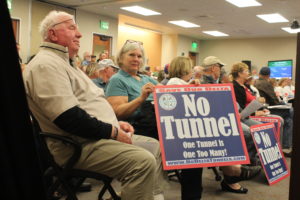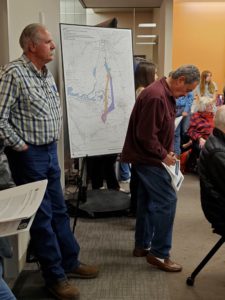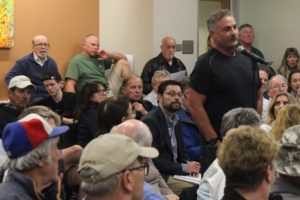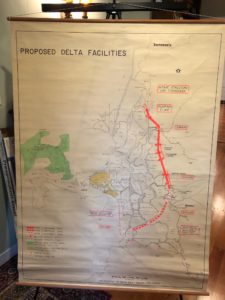
Delta residents hold up “Save our Delta: No Tunnel” signs at the Department of Water Resources Scoping Meeting in Brentwood on Feb. 20.
Photo by Galen Kusic
Galen Kusic, Editor
On Jan. 15, the Department of Water Resources (DWR) released the Notice of Preparation to start the environmental review process for a single tunnel project to divert water from the Sacramento River south via intakes to the Tracy pumps.
Former Gov. Jerry Brown’s twin tunnels or California WaterFix was abandoned in 2019 by Gov. Gavin Newsom, but the first-term governor has revived the project as a single tunnel alternative. While the project is considerably smaller, the design would include a 6,000 cubic feet per second (cfs) tunnel, constructed 150 feet underneath the Delta.
Brown’s original plan is back – in a condensed version of the 1970’s plan to build a peripheral canal that was rejected by voters in a 1982 referendum.
Newsom’s goal, as outlined in the state’s Water Resilience Portfolio, is to complete the revamped project’s environmental review by early 2022, with final biological opinions and all environmental permits completed by the end of that year. Public comments on the project are due by March 20, 2020. To submit written comments, e-mail them to DeltaConveyanceScoping@water.ca.gov.
Over the past month, DWR has been holding scoping meetings in the Delta and select locations throughout the state. At meetings in Walnut Grove, Stockton, Clarksburg and Brentwood, a diverse group of farmers, fishermen, elected officials, climate/social justice activists, economists and engineers came out in force to oppose what is often referred to as the “boondoggle” project.
“This project is astronomically wrong,” said Sutter Island farmer Tim Neuharth at the Feb. 10 scoping meeting in Walnut Grove. “There are alternatives…but I don’t see any alternatives. It’s the same map we’ve been looking at for years. Where are the alternatives?”
The project’s preferred alternative would construct two intakes on the Sacramento, with the possibility for a third. The intakes would be located near the Delta legacy communities of Clarksburg, Hood and Courtland and would span nearly a mile on the river – completely altering critical endangered species habitat, agriculture and the Delta’s picturesque landscape. Construction is expected to last upwards of 10 years.
“A common mantra has been one cannot take more water from an estuary and expect it to be resilient,” said Clarksburg resident and North Delta C.A.R.E.S. representative Barbara Daly. “One tunnel is no better than two tunnels.”
At meetings, residents consistently emphasized that the plan does not follow the co-equal goals, charged in the Delta Reform Act of 2009.

Mayor of Oakley Kevin Romick (left) listens on after speaking out against the tunnel project as other residents give alternatives and cite the many flaws with the project’s design.
Photo by Galen Kusic
The Delta Reform Act and Delta Plan require a conveyance facility to meet: “the two goals of providing a more reliable water supply for California and protecting, restoring, and enhancing the Delta ecosystem. The coequal goals shall be achieved in a manner that protects and enhances the unique cultural, recreational, natural resource, and agricultural values of the Delta as an evolving place.”
CA WaterFix largely failed because it did not meet the co-equal goals set forth by the Delta Stewardship Council, who voted not to approve the plan in 2018. Unless the Newsom administration starts to consider a wide range of alternatives, many fear he is in danger of repeating the same mistake.
Thousands of Delta residents and Calif. citizens have voiced that the project is not only bad for the environment, but the thriving Delta agriculture and recreation economy. The public has harped on common-sense alternatives, such as desalination, recycling, regional self-sufficiency and additional water storage to meet water supply demands for an ever-increasing population in a drought-stricken state. Even far less destructive alternatives like the Western Delta Intake Concept (WDIC) by engineer Dr. Robert Pyke have fallen on deaf ears from the state for nearly a decade after he created the proposal.
“Nine years have passed,” said Pyke at the Feb. 20 scoping meeting in Brentwood. “I hope it’s still not too late to listen to any new ideas, or to listen to public input.”
Stockton resident Jaelyn Sanidad spoke at the Stockton scoping meeting on Feb. 13 about the negative impacts the proposed conveyance project will have on environmental justice communities throughout the state.
“Environmental racism and injustice has made its dent in Stockton, our motherland, for far too long,” she said. “I am not just a statistic here to play with. We are here fighting for our lives. We are nature defending nature.”
A question was asked by an attendee of the Brentwood meeting if anyone in the audience was “for” the project.
Not one raised their hand, as boos echoed the room.
While the Trump administration continues to remove regulatory roadblocks to pump additional water south, endangered fish species are threatened more than ever. The Newsom administration has sued the Trump administration to “challenge the federal biological opinions to protect highly imperiled fish species close to extinction.”
“Our goal continues to be to realize enforceable voluntary agreements that provide the best immediate protection for Delta species, reliable and safe drinking water, and dependable water sources for our farmers for economic prosperity,” Newsom said in a statement.
Delta activists are indeed happy that Newsom has stood up to Trump, but still fear that he will push the tunnel project forward despite an abundance of science that states the tunnel will “decimate” the estuary and its hundreds of bird and fish species.

Attendees of the DWR Tunnel Scoping Meeting in Brentwood listen as Save the California Delta Alliance attorney Michael Brodsky calls the State Water Project a “climate atrocity.”
Photo by Galen Kusic
“I can’t see why the governor is looking at this project unless he’s got something personal to gain from it,” said Discovery Bay resident Mike Guzzardo. “It’s a dangerous project anyway you look at it.”
Restore the Delta’s Mariah Looney cited that south Stockton residents don’t even want to go in the water for fear of toxic algal blooms and pollution. She notes that construction of a tunnel would only further degrade water quality and increase saltwater intrusion in the south Delta.
“We strongly urge a no tunnel alternative,” she said.
Contra Costa Supervisor Diane Burgis spoke out against the tunnel, citing its many negative impacts, including lack of flood control, environmental health, land use, air quality, groundwater and transportation to name a few.
“This idea of moving water from one place to another is older than ideas like…cell phones,” she said. “And how far have we gotten? Technology has told us we can do more…we don’t need to build a conveyance or a pipe to do that.”
While the state claims its main objectives of the project include minimizing water supply disruption due to seismic risk and protecting water supply reliability – it has done little to improve the state’s aging levee system and a sinking, cracking California Aqueduct that ships water to Los Angeles from the Delta. An estimated 30 percent of that water evaporates before it ever reaches its final destination.
Michael Brodsky, counsel for Save the California Delta Alliance commented on the importance of strengthening the current levee system and the construction of setback levees to ensure a more reliable water supply with added habitat benefits. He also emphasized the need for more freshwater flows through the Delta to combat sea level rise and salinity.
“They’re (State Water Project deliveries) not reliable because you’ve promised water to too many places,” he said. “The State Water Project is a climate atrocity. Gavin Newsom has to face up to that.”

A 1972 map of the proposed peripheral canal. Residents have cited that the plan is by-and-large the same today.
In Clarksburg, residents brought out a map from 1972 that largely resembled the identical project being proposed today. Two routes are being considered – one directly through the central Delta and legacy communities like Locke, or an equally destructive eastern route that would tear through sensitive Delta habitat.
Update:
March 3 in Redding, hundreds of climate activists and members of local Native American tribes including Yurok, Karuk, Winnemem Wintu, Pit River and Miwok rallied against the tunnel plan at the final DWR scoping meeting.
Tribal leaders note that the tunnel will severely impact salmon populations on tributaries to the Sacramento River, including the Trinity and Klamath Rivers. State salmon fishing restrictions are likely to be placed this year due to record low returns on the Klamath, hindering the tribal economy. Leaders stress that the construction of more conveyance would ultimately wipe out salmon populations.
“In solidarity, the Yurok Tribe stands with the Trinity River and all its tributaries recognizing that as the rivers’ steward, we must speak out for the Trinity’s viability and fight for its life,” said Yurok Tribe Chairman Joseph L. James in a release.
Winnemem Wintu Chief Caleen Sisk has been a staunch opponent to the tunnel project and Sites Reservoir, citing that endangered salmon populations would not recover from more water pumped south. Sisk and the tribe have also fought hard against the proposal to raise Shasta Dam by 18 feet, which would flood countless sacred burial sites and potentially further impact salmon returns.
(This article was originally published in the March 4 print edition of the Herald and updated for the online version)






The Sacramento River Council, which I founded in 1986, and merged into the Sacramento River Preservation Trust in 1996, was instrumental in getting the first Pacific salmon listings as threatened and endangered. The species was the Sacramento River winter-run Chinook salmon. The winter-run is now poised on the brink of extinction as a result of the loss of its most critical habitat: the Sacramento-San Joaquin River Delta by the proposed Delta Tunnel. We must stop this thoughtless destruction by the State of California at the behest of Westlands Water District and greedy, power-corrupted industrial agriculture.
There is a far better solution than the various conveyances, whether peripheral canals or tunnel(s) that California’s Governors have been pushing since the 1980s. Let the river waters of the Sacramento and San Joaquin rivers pass completely through the Delta as they did before the Central Valley Project and State Water Project began operating. Capture 1.4 Million Acre feet of fresh water per year at Sherman Island (at the confluence of the Sac. & San Joaquin Rivers) Add 1 Million Acre feet of new water created on Sherman Island by solar powered brackish water desalination and convey that water through a smaller tunnel that is south of the Delta to Bethany Reservoir where it enters the California Aqueduct. This would add 1 MAF of fresh water to the system and 1 MAF of fresh water to the San Francisco Bay-Delta estuary to benefit fish and wildlife. CREATING NEW WATER IS THE ONLY SOLUTION. Go to http://www.solagra.com and click on the 6 minute video detailing the SolAgra Water Solution.